Physics II Class 02/26
Find the equation of a standing wave in a string whose
mass is 40 grams, length 5 meters under tension 50 Newtons.
We first find the velocity of the wave as indicated below.
We then recall that the node-antinode configuration leads
us to the conclusion that the wavelength of the nth harmonic is 2 / n * L.
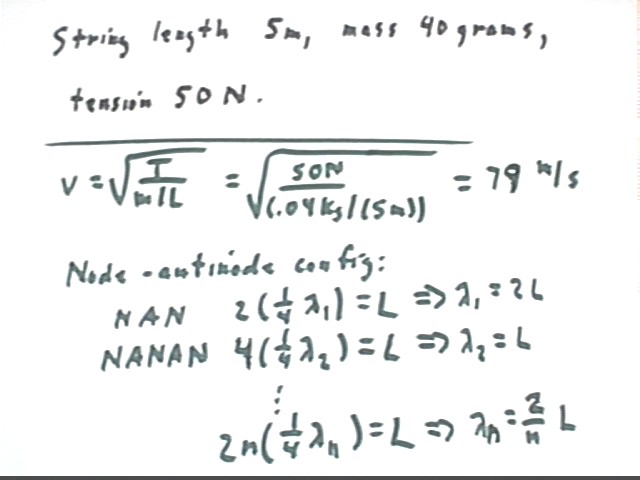
The equation of any harmonic is y = A sin(omega t) sin(k
x), where omega = 2 pi f where f = v / lambda and k = 2 pi / lambda. So if we know
the wavelength lambda of the harmonic and the propagation velocity v (the same for all
harmonics) we can find the equation of motion for that harmonic.
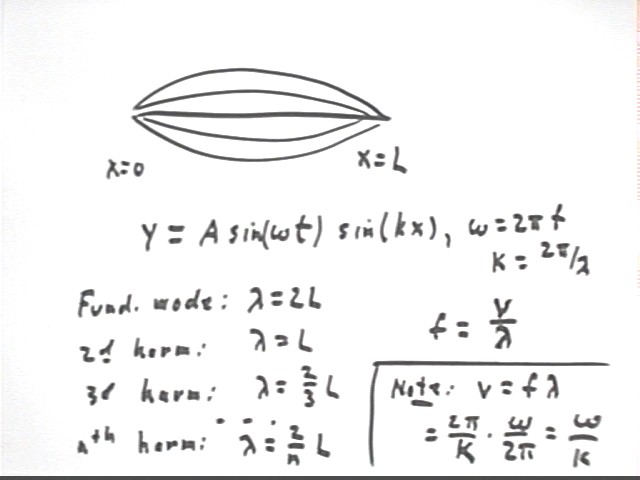
The propagation velocity v = 79 m/s and the wavelengths
10m, 5 m, 10/3 m, etc. give us frequencies f1, f2, f3, ... of 7.9 Hz, 15.8 Hz, 23.7 Hz,
..., with general frequency 7.9 * n Hz for the nth harmonic.
The angular frequencies omega1, omega2, omega3, etc. are
about 49 rad/s, 98 rad/s, etc. with general angular frequency omega(n) = 7.9 * 2 pi n
rad/s. The corresponding wave numbers are k1 = 2 pi / 10 m^-1, k2 = 2 pi / 5 m^-1,
and in general kn = 2 pi n / 10 m^-1 = n * pi / 5 m^-1
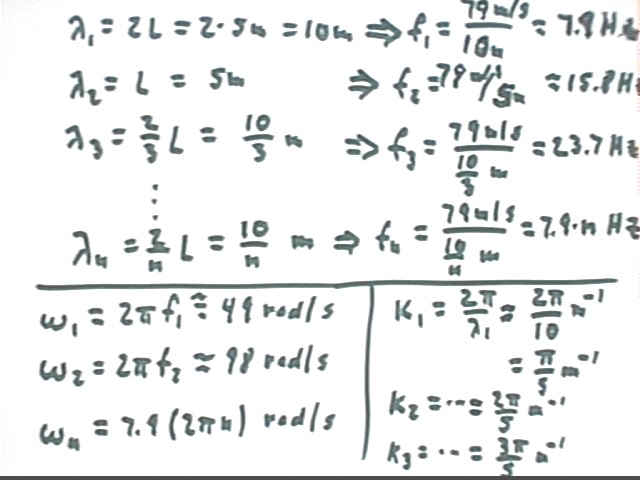
The corresponding waveforms for the first five harmonics
are given below:
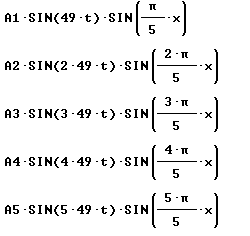
The general equation of the wave standing wave is the
superposition of all these harmonics. Using A1, A2, ... for the amplitudes of the
various harmonics we have the general equation shown below.
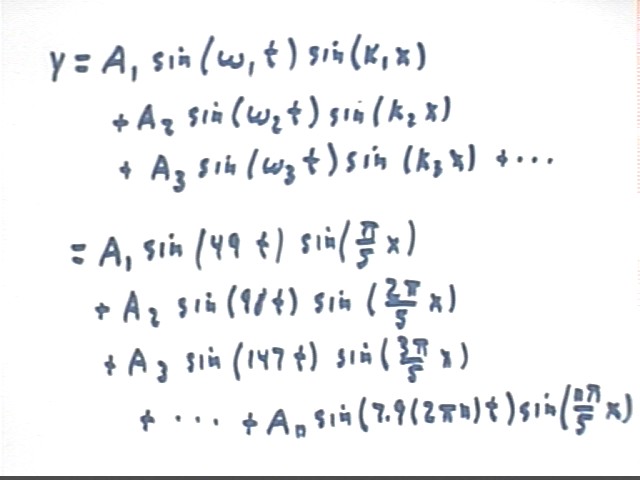
The harmonics in the figure below are more accurate
versions of the above, using the ridiculously accurate 2 pi / 0.1264811064 rad/s instead
of the approximation 49 rad/s used above. Note how the coefficients of the 2 pi in
the numerator of the first sine function are 1, 2, 3, 4 and 5, showing how the frequencies
of the harmonics increase as multiples of the fundamental frequency.
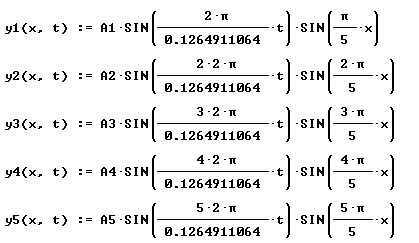
Looking at just the first harmonic y1(x, t) we see that
when t = 0 we get y(x, 0) = A1 sin(49 * 0) sin(pi/5 * x)
= 0, corresponding to a 'flat' wave with y = 0 at every point
when t = .016 we get y(x, .016) = A1 sin(49 * .016)
sin(pi/5 * x) = .71 A1 sin(pi/5 x), corresponding to a waveform with nodes at x = 0 and x
= 5 and a max value of .71 A1 at the antinode point x = 2.5 m.
As t continues to increase the waveform will first reach
its maximum antinode displacement A1, then will return to the 'flat' waveform, the will
move below the flat waveform to max negative displacement -A1 before returning to the flat
waveform and starting the cycle over.
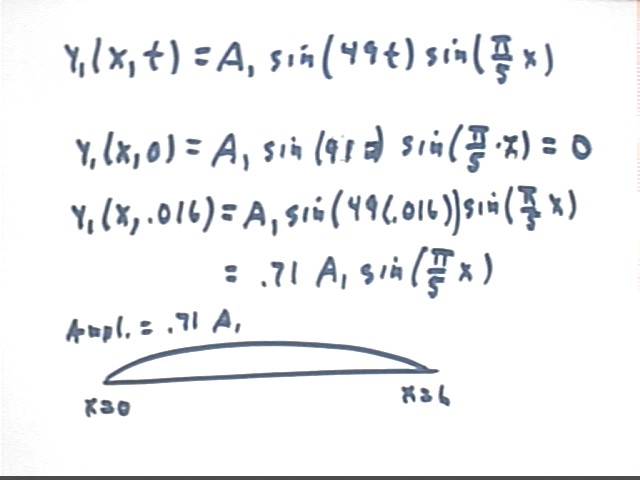
The 2d harmonic y2(x, t) will oscillate as indicated
below, with nodes at the endpoints and the midpoint.
This mode of vibration (at twice the frequency of the
fundamental) superimposed on the fundamental described above gives us the most familiar
behavior of the wave simulation.
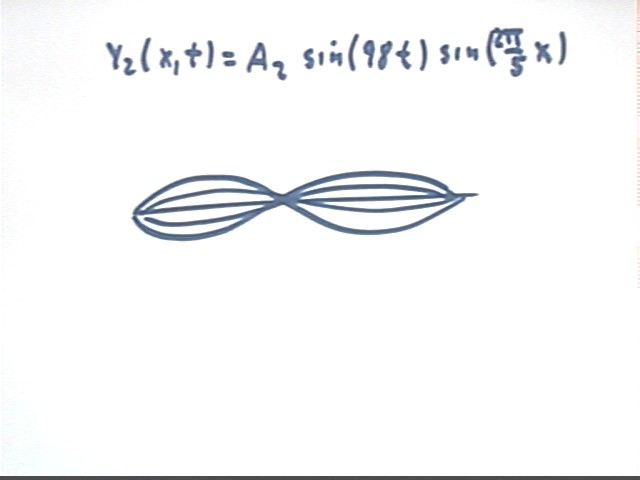
If we add the first five harmonics we get the function
y(x,t) in the figure below.

This function can be abbreviated as y(x, t) := y1(x, t) + y2(x, t) +
y3(x, t) + y4(x, t) + y5(x, t).
If the values of A1, ..., A5 are set as indicated below,
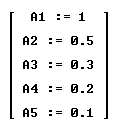
with each harmonic having a bit less amplitude than the preceding, we
get the function
- y = SIN(49.67294133·t)·SIN(0.6283185307·x)
+0.5·SIN(99.34588266·t)·SIN(1.256637061·x) +
0.3·SIN(149.0188239·t)·SIN(1.884955592·x) +
0.2·SIN(198.6917653·t)·SIN(2.513274122·x) +
0.1·SIN(248.3647066·t)·SIN(3.141592653·x)
Plotting this function from x = 0 to x = 5 gives us the succession of
waveforms indicated below:
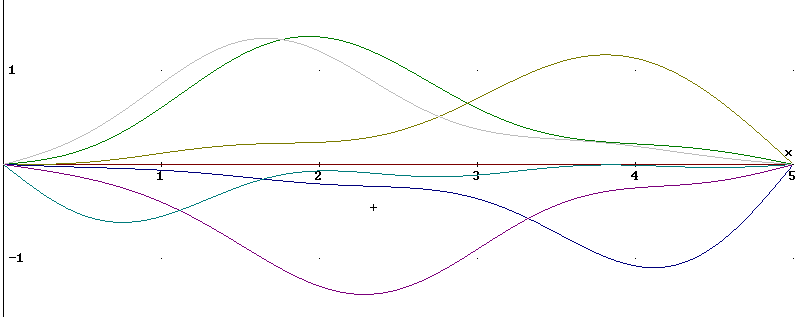
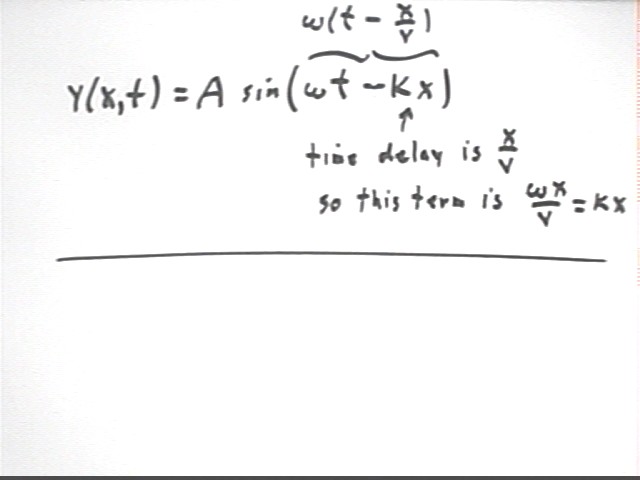
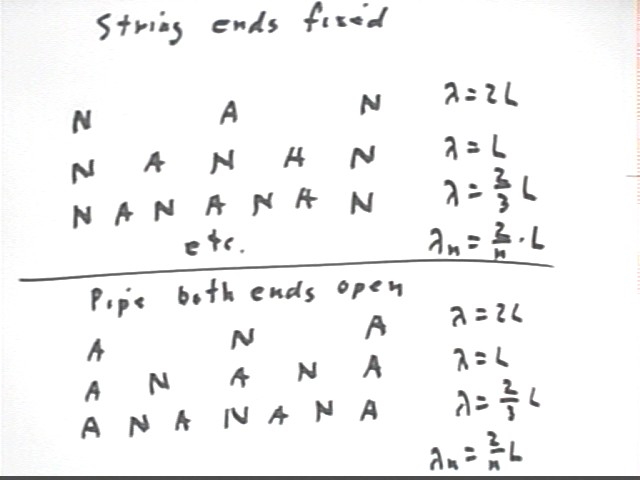

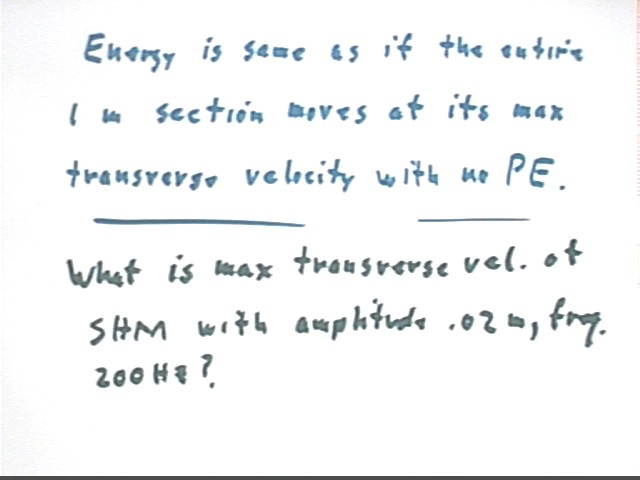
Assignment 14
`gChapter 12 Problems 42, 46,
48, 52, 53 //
`uUniversity Physics:
Ch. 21 Problems 23, 24, 26, 27, 30
Assignment 15:
`gCh. 23 Problems 4, 11, 14, 17, 20//
`uUniversity Physics: Ch. 34,
Problems 25, 28, 35, 40, 42//
Assignment 16:
`gCh. 23 Problems 23, 34, 37, 43, 52//
`uUniversity Physics: Ch. 35,
Problems 45, 52, 59, 62, 68, 75//
`gCh. 23 Problems 58, 61; Ch. 24 Problems
4, 7, 10 Submit Ch. 24 #10//
`uUniversity Physics: Ch. 37,
Problems 37, 40, 46, 49, 54 Submit Ch. 37 #44//
Assignment 18:
`gCh. 24 Problems 15, 23, 28, 31,
34 //
`uUniversity Physics: Ch. 38,
Problems 40, 45, 46, 49, 51//
Assignment 19:
`gCh. 24 Problems 40, 43, 46, 51, 57,
60 Submit Ch. 24 #43//
Assignment 25:
`gText Chapter 16, Problems 8, 11, 14, 18
`uUniversity Physics: Chapter 22
Problems 52, 54, 57, 60, 63, 66, 67, 74, 79, 83, 84
Assignment 26:
`gText Chapter 16, Problems 26, 29, 32, 35
`uUniversity Physics: Chapter 23
Problems 20, 21, 25, 27, 33, 34, 40, 41
Assignment 27:
`gText Chapter 17, Problems 9, 12, 16, 19,
22
`uUniversity Physics: Chapter 24
Problems 49, 50, 55, 57, 58, 61, 65, 72, 75
Assignment 28:
`gText Chapter 17, Problems 34, 37, 39, 45,
48
`uUniversity Physics: Chapter 25
Problems 36, 37, 42, 45, 46, 49, 52
Assignment 29:
`gText Chapter 18, Problems 6, 7, 9, 12,
29, 36
`uUniversity Physics: Chapter 26
Problems 44, 47, 50, 55, 60, 61
Assignment 30:
`gText Chapter 20, Problems 11, 13, 17, 21,
32 Submit #32//
`uUniversity Physics: Chapter 28 Problems 41, 42, 46, 52,
57, 65, 66; Chapter 29 Problems 43, 46, 51, 56
Assignment 31:
`gText Chapter 21, Problems 10, 12, 15,
22
`uUniversity Physics: Chapter 30
Problems 31, 36, 41, 46















